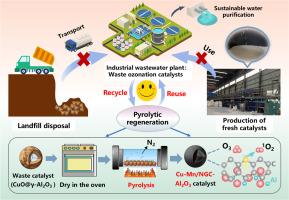In-situ recycling of waste ozonation catalysts into N-doped graphitic carbon-alumina structures induces a non-radical pathway towards water purification
IF 12.4
1区 环境科学与生态学
Q1 ENGINEERING, ENVIRONMENTAL
引用次数: 0
Abstract
With the widespread application of catalytic ozonation in the advanced treatment of industrial wastewater, the increasing of waste ozonation catalysts has posed substantial environmental and economic challenges. Although waste catalysts represent an attractive resource, environmentally friendly and efficient recycling strategies remain elusive due to their complex structures and compositions. Herein, we propose a one-step pyrolysis strategy to ingeniously recycle waste catalysts into composite catalysts (Cu-Mn/NGC-Al2O3) for industrial wastewater treatment. This procedure involves the in-situ graphitization of extracellular polymeric substances from the waste catalysts onto the pristine Al2O3 substrates, and trace amounts of copper and manganese undergo redox-reactive recycling to form nanoparticles. Waste catalyst-derived Cu-Mn/NGC-Al2O3 demonstrates recovery of 80.83% activity of the original fresh catalysts, along with excellent stability. Unlike the radical oxidation of fresh catalysts, we identify that Cu-Mn/NGC-Al2O3 configuration induces a non-radical pathway based on singlet oxygen with a contribution of 84.09%. Life cycle assessment and economic analysis indicate that recycling waste catalysts to Cu-Mn/NGC-Al2O3 achieves a 93.89% reduction in carbon emissions and saves approximately 58.58% in costs. This study promotes the recycling of waste catalysts and maximizes the utilization of resources from waste catalysts, achieving the goal of the low-carbon transition.

原位回收废臭氧氧化催化剂成n掺杂石墨碳-氧化铝结构诱导非自由基途径水净化
随着催化臭氧化技术在工业废水深度处理中的广泛应用,废水臭氧化催化剂的不断增加对环境和经济造成了巨大的挑战。虽然废物催化剂是一种有吸引力的资源,但由于其结构和成分复杂,环境友好和有效的回收策略仍然难以捉摸。在此,我们提出了一种一步热解策略,巧妙地将废催化剂回收为Cu-Mn/NGC-Al2O3复合催化剂,用于工业废水处理。该过程包括将来自废催化剂的胞外聚合物质原位石墨化到原始的Al2O3衬底上,微量的铜和锰进行氧化还原反应回收以形成纳米颗粒。废催化剂衍生的Cu-Mn/NGC-Al2O3具有80.83%的活性,且具有良好的稳定性。与新鲜催化剂的自由基氧化不同,我们发现Cu-Mn/NGC-Al2O3结构诱导了基于单线态氧的非自由基氧化途径,贡献为84.09%。生命周期评价和经济分析表明,将废催化剂回收为Cu-Mn/NGC-Al2O3,碳排放量减少93.89%,成本节约约58.58%。本研究促进了废催化剂的回收利用,最大限度地利用废催化剂的资源,实现了低碳转型的目标。
本文章由计算机程序翻译,如有差异,请以英文原文为准。
求助全文
约1分钟内获得全文
求助全文
来源期刊

Water Research
环境科学-工程:环境
CiteScore
20.80
自引率
9.40%
发文量
1307
审稿时长
38 days
期刊介绍:
Water Research, along with its open access companion journal Water Research X, serves as a platform for publishing original research papers covering various aspects of the science and technology related to the anthropogenic water cycle, water quality, and its management worldwide. The audience targeted by the journal comprises biologists, chemical engineers, chemists, civil engineers, environmental engineers, limnologists, and microbiologists. The scope of the journal include:
•Treatment processes for water and wastewaters (municipal, agricultural, industrial, and on-site treatment), including resource recovery and residuals management;
•Urban hydrology including sewer systems, stormwater management, and green infrastructure;
•Drinking water treatment and distribution;
•Potable and non-potable water reuse;
•Sanitation, public health, and risk assessment;
•Anaerobic digestion, solid and hazardous waste management, including source characterization and the effects and control of leachates and gaseous emissions;
•Contaminants (chemical, microbial, anthropogenic particles such as nanoparticles or microplastics) and related water quality sensing, monitoring, fate, and assessment;
•Anthropogenic impacts on inland, tidal, coastal and urban waters, focusing on surface and ground waters, and point and non-point sources of pollution;
•Environmental restoration, linked to surface water, groundwater and groundwater remediation;
•Analysis of the interfaces between sediments and water, and between water and atmosphere, focusing specifically on anthropogenic impacts;
•Mathematical modelling, systems analysis, machine learning, and beneficial use of big data related to the anthropogenic water cycle;
•Socio-economic, policy, and regulations studies.
 求助内容:
求助内容: 应助结果提醒方式:
应助结果提醒方式:


